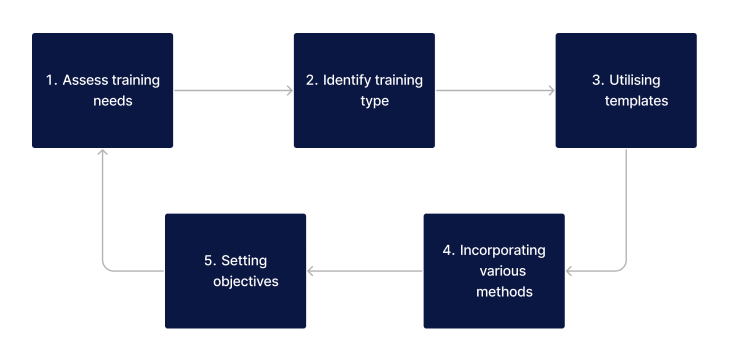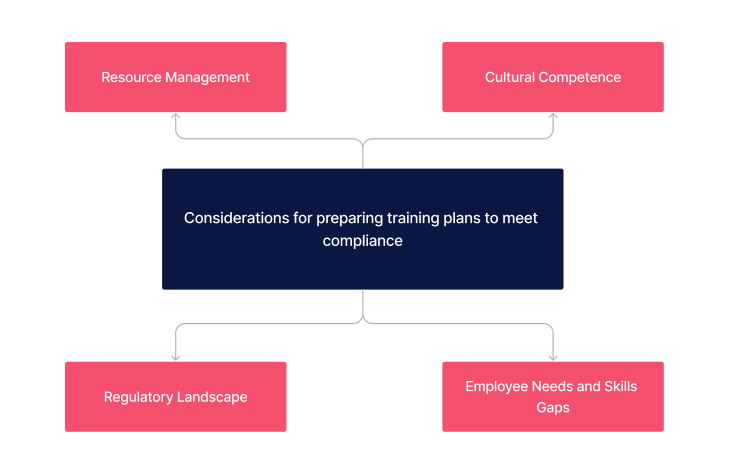Effective training plans are crucial in ensuring compliance within the healthcare system. They play a pivotal role in maintaining the standards of healthcare services, from primary to urgent care, including sectors like aged care and public health. This guide aims to assist education and learning and development managers in creating comprehensive training plans that align with healthcare compliance needs.
How Do Training Plans Support Meeting Compliance Needs?
Training plans are key in familiarising team members with the healthcare system's regulatory framework, including health insurance policies, mental health protocols, and enforceable undertakings. A well-structured training plan ensures that employees are up-to-date with the latest compliance standards, thereby enhancing the overall quality of health services. For instance, in the context of the Australian healthcare system, it's important to train staff on the nuances of Medicare, the NDIS, and the standards set by the Australian Commission on Safety and Quality in Health.
Importance of Training Plans to Meet Healthcare Compliance
Adherence to compliance is not just a legal requirement but also a moral obligation to ensure patient safety and care. Training plans enable healthcare providers to stay informed about changes in legislation and best practices, thus ensuring continuous improvement in service delivery. For example, in aged care, where compliance with the Aged Care Quality and Safety Commission's standards is vital, training plans can significantly improve care quality.
How to Prepare a Training Plan to Meet Healthcare Compliance?

Preparing a training plan that aligns with healthcare compliance is a multifaceted process, crucial in the context of the Australian healthcare system. It involves understanding the intricacies of Medicare, the National Disability Insurance Scheme (NDIS), and the regulations set forth by entities like the Australian Commission on Safety and Quality in Health. A robust training plan not only equips healthcare professionals with the necessary knowledge and skills but also embeds a culture of continuous learning and adherence to the highest standards of patient care. Given the dynamic nature of healthcare regulations and the diverse range of services from aged care to urgent care, training plans must be comprehensive, flexible, and tailored to meet the specific needs of various healthcare settings.
The preparation process involves the following key steps:
- Assessing Training Needs: Conduct a thorough analysis of the existing skills and knowledge within the healthcare setting. This involves identifying areas where compliance-related knowledge is lacking and understanding the unique requirements of different roles, whether they are in direct patient care, administrative, or support roles.
- Identifying Training Type: Based on the assessment, determine the types of training that will be most effective. This could include hands-on training for clinical skills, workshops for understanding legal obligations, or online modules for convenience and broader reach.
- Utilising Templates: Leverage employee training plan templates to ensure a structured and consistent approach. These templates can serve as a guide to cover all necessary compliance topics systematically.
- Incorporating Various Methods: Embrace a mix of training methods to cater to different learning styles and job functions. This could include interactive simulations for emergency response training, discussion forums for policy understanding, and case studies relevant to the Australian healthcare context.
- Setting Objectives: Define clear, measurable objectives for the training process. This should include timelines, evaluation methods, and benchmarks for success, ensuring that the training is not only completed but also effective in enhancing compliance.
Considerations When Preparing Training Plans for Healthcare Compliance

When developing a training plan for healthcare compliance, it's imperative to consider a range of factors that can impact its effectiveness. In Australia, where the healthcare landscape is governed by complex regulations and a diverse population, these considerations become even more critical. The training plan should not only address the legal aspects of compliance but also the ethical and cultural dimensions of healthcare delivery. This involves understanding the unique needs of different patient demographics, including cultural sensitivities and language barriers, which are particularly relevant in Australia's multicultural society.
Key considerations include:
- Regulatory Landscape: Stay abreast of the latest healthcare regulations and standards, including those specific to different areas like mental health, aged care, and primary care. Understanding the nuances of these regulations and how they apply to various aspects of healthcare delivery is essential.
- Employee Needs and Skills Gaps: Each team member may have different training needs based on their role and experience. Tailoring the training to address these gaps ensures that all staff members are equipped to meet compliance requirements effectively.
- Resource Management: Efficiently manage resources such as time, financial investment, and training materials. This includes considering the cost-effectiveness of different training methods and the availability of trainers and facilities.
- Cultural Competence: Incorporate training elements that promote cultural competence among healthcare providers. This is crucial in delivering patient-centered care in Australia's diverse society and in complying with standards that promote equity and respect in healthcare.
Want a healthcare LMS that can help prepare your training plans for compliance?
Contact Ausmed today and see how we can support your organisation!
What Tools Can Support Preparing Training Plans to Meet Healthcare Compliance?
Various tools can facilitate the development of effective training plans:
| Tool | Description | Benefits | Application in Healthcare |
|---|---|---|---|
| Employee Development Plan Software | Software for creating personalised training paths, setting individual goals, tracking progress, and providing feedback. | Personalised learning experiences, progress tracking, and adaptable training modules. | Tailoring training for different healthcare roles, ensuring relevant and targeted learning. |
| Training Plan Templates | Standardised templates for designing training programs, including objectives, methods, materials, and evaluation criteria. | Consistency in training delivery, time-saving, and comprehensive coverage of compliance aspects. | Useful in large healthcare settings to ensure uniformity and completeness across programs. |
| E-Learning Platforms and Modules | Online learning platforms with interactive modules, video tutorials, and quizzes. | Flexible training options, reduced physical space needs, and easy updates for changing regulations. | Ideal for ongoing compliance training, especially where in-person training is impractical or for remote staff. |
| Virtual Reality (VR) and Simulation Tools | Tools for immersive learning experiences, allowing practice of skills and decision-making in a virtual environment. | Enhances practical skills, safe learning environment, and improved engagement and information retention. | Training in emergency response, surgical procedures, and patient interaction scenarios. |
| Cost-effective for both learners and institutions | Tools for monitoring compliance levels, documenting training completion, and generating reports for regulatory bodies. | Accountability, evidence of compliance, and identification of training needs. | Essential for maintaining records of training activities and compliance status, important for audits and inspections. |
Related Resources
- LMS in Healthcare: The Roles, Benefits and Pros and Cons
- Mandatory Training: How an LMS can help you meet requirements
- Guide to Mandatory Training
- Mandatory Training in Aged Care (A Guide for Managers)
- Adapting to Regulatory Changes in Healthcare Training
- Policy Management: A Guide for Healthcare Managers
- Guide to Compliance Training (for Healthcare Managers)
- A Guide to Creating Your Own Training Modules
- A Step-by-Step Guide to Data Collection for Learning Analytics
Conclusion
Creating a comprehensive training plan is essential for meeting healthcare compliance requirements. By considering the unique needs of the healthcare sector, including aged care and mental health, and utilising appropriate tools and templates, education and learning managers can develop effective and compliant training programs that enhance the quality of health services. In the Australian context, this means aligning with systems like Medicare, the NDIS, and adhering to standards set by relevant commissions and authorities.
References
- Department of Health, Australian Government. (2022). "Healthcare Compliance and Training Guidelines." Canberra: Department of Health.
- Australian Commission on Safety and Quality in Health Care. (2021). "National Standards for Healthcare Compliance." Sydney: ACSQHC.
- Aged Care Quality and Safety Commission. (2023). "Aged Care Training and Compliance Framework." Melbourne: ACQSC.
- National Disability Insurance Scheme. (2022). "NDIS Compliance and Training Requirements." Brisbane: NDIS.
- Smith, J., & Taylor, A. (2021). "Effective Training Strategies in Australian Healthcare." Australian Health Review, 45(3), 345-356.
- Australian Healthcare and Hospitals Association. (2020). "Improving Healthcare Compliance through Training: An Australian Perspective." AHHA White Paper Series.



